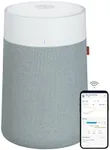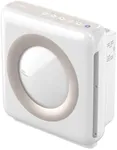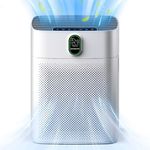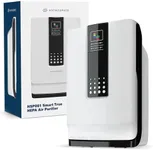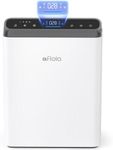Buying Guide for the Best Air Purifier For Baby Rooms
Choosing an air purifier for a baby's room is an important decision because clean air can help protect your child from allergens, dust, and other airborne particles. Babies are more sensitive to air quality, so it's essential to pick a purifier that is effective, quiet, and safe. When shopping, focus on the features that matter most for a nursery environment, such as filtration efficiency, noise level, and safety features. Understanding the key specifications will help you make a choice that keeps your baby's room healthy and comfortable.Filtration TypeFiltration type refers to the kind of filter the air purifier uses to clean the air. The most common types are HEPA filters, activated carbon filters, and sometimes UV or ionizer features. HEPA filters are highly effective at capturing tiny particles like dust, pollen, and pet dander, which is especially important for babies with allergies or sensitive lungs. Activated carbon filters help remove odors and some chemicals. For a baby's room, a true HEPA filter is usually the best choice because it captures the smallest and most harmful particles. If you are concerned about smells or chemical fumes, look for a model that also includes an activated carbon filter. Avoid ionizers or UV features if you want to minimize exposure to ozone or other byproducts.
Room Coverage (CADR or Square Footage)Room coverage tells you how large of a space the air purifier can effectively clean, often measured in square feet or by the Clean Air Delivery Rate (CADR). This is important because a purifier that's too small won't clean the air efficiently, while one that's too large may be unnecessarily bulky or use more energy. For a baby's room, measure the room's size and choose a purifier rated for at least that square footage. If your nursery is small, a compact model will suffice, but for larger rooms, make sure the purifier can handle the extra space.
Noise LevelNoise level indicates how loud the air purifier is when running, usually measured in decibels (dB). This is crucial for a baby's room because loud noises can disturb sleep. Air purifiers typically have different speed settings, with lower speeds being quieter. Look for models that specify a low noise level, especially on their lowest setting. If your baby is a light sleeper, prioritize purifiers that are known for quiet operation, ideally below 30 dB on the lowest setting.
Safety FeaturesSafety features include things like child lock, tip-over protection, and the use of safe materials. These are important in a nursery to prevent accidents or tampering. A child lock can stop curious hands from changing settings, and tip-over protection ensures the device shuts off if knocked over. When choosing, consider how mobile your baby is and whether the purifier will be within reach. If so, prioritize models with these safety features.
Filter Replacement IndicatorA filter replacement indicator is a feature that alerts you when it's time to change the filter. This is important because a clogged or dirty filter won't clean the air effectively, which defeats the purpose of having a purifier in your baby's room. If you want to ensure consistent air quality without having to remember maintenance schedules, look for a model with a clear and easy-to-understand indicator.
Energy EfficiencyEnergy efficiency refers to how much electricity the air purifier uses. Since you may want to run the purifier continuously in a baby's room, choosing an energy-efficient model can help reduce your electricity usage. Look for purifiers that are labeled as energy efficient or have low power consumption, especially if you plan to keep it on day and night.



